How To Make Black Garlic
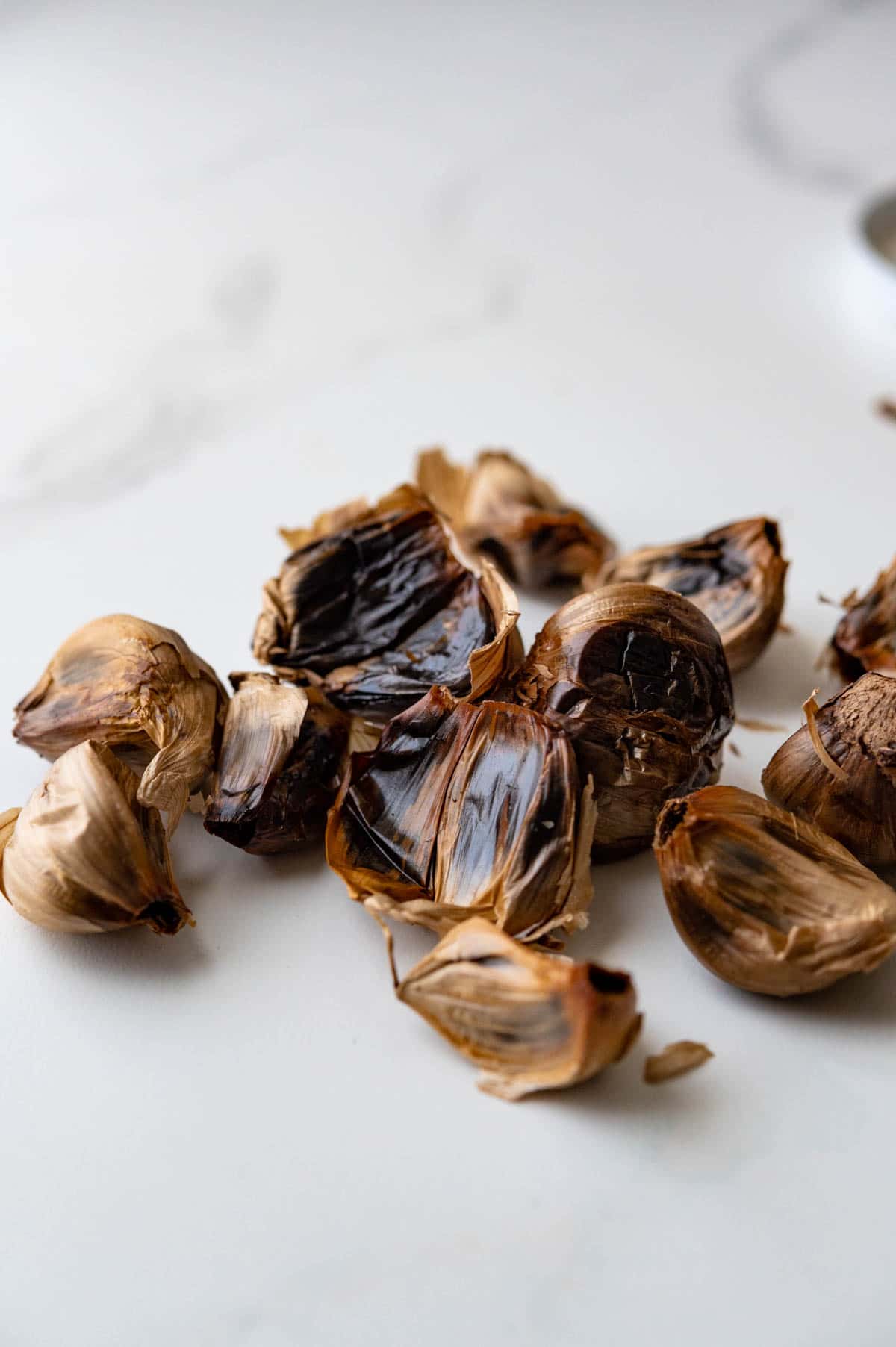
Black garlic isn’t a unique variety of allium. It’s regular garlic that’s transformed over time through consistently warm, humid conditions. The result is a soft, mellow, funky, rich, and, yes, black-colored garlic that enhances anything you add. In this post, I’ll show you how to make black garlic at home in the Instant Pot, give instructions for making it in a slow cooker, rice cooker, or food fermenter and give you a few ideas on what to do with your homemade fermented garlic.
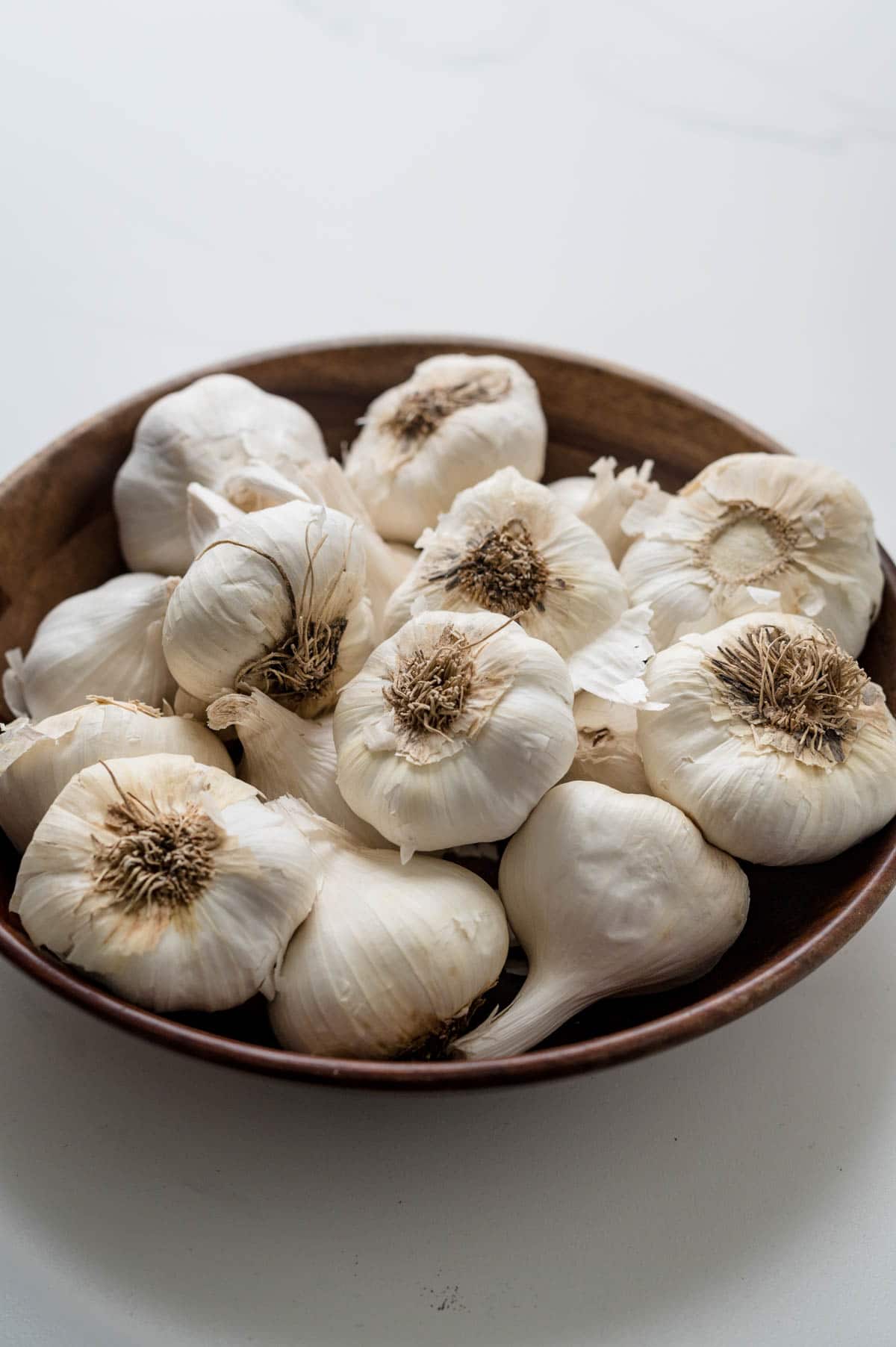
Table of Contents
- 1 Black garlic
- 2 What you’ll need to make black garlic at home:
- 3 Setting up the garlic station
- 4 How to make fermented garlic in the Instant Pot
- 5 How to know when black garlic is done
- 6 Making black garlic in the slow cooker or rice cooker
- 7 Making black garlic in a food fermenter
- 8 FAQ’s
- 9 What about food safety?
- 10 How to use black garlic
- 11 How To Make Black Garlic
Black garlic
Attention all foodies. Here’s the ultimate geek-out recipe/project. Black Garlic.
These magical garlic cloves have transformed from pungent eye-stinging allium to mellow and funky with a tangy molasses vibe. Unlike hard cloves of raw garlic, these are soft and spreadable.
What is black garlic?
Black garlic is garlic that’s been kept in a precise warm, humid environment for several weeks (or months) producing a chemical reaction between the naturally occurring amino acids and sugars present in the allium.
Black garlic is not fermented garlic. Instead, it has undergone a Maillard reaction, which is a browning process. It gives black garlic its distinctive flavor and softens the cloves (literally) into something tangy, earthy & rich with a soft, sticky consistency that can easily be mashed with the tines of a fork.
Watch the video to see how simple making black garlic in an Instant Pot is.
I did a video to show you how I made my black garlic using my Instant Pot. (Not shown in the video are the multiple times I checked to see how my garlic was progressing).
What does black garlic taste like?
Unlike fresh, black garlic has lost its characteristic sting and sharpness and the resulting flavor is sweet and tangy with a bit of umami richness and funk.
Some equate the flavor to tamarind, balsamic vinegar, or soy sauce. I find that black garlic’s tangy, umami flavor enriches other foods and heightens their natural flavors. You’ll be amazed how this secret ingredient can elevate your everyday cooking.
Where did it originate?
Black garlic is thought to have originated in Korea but has been widely used for centuries in Asian countries like Japan and China.
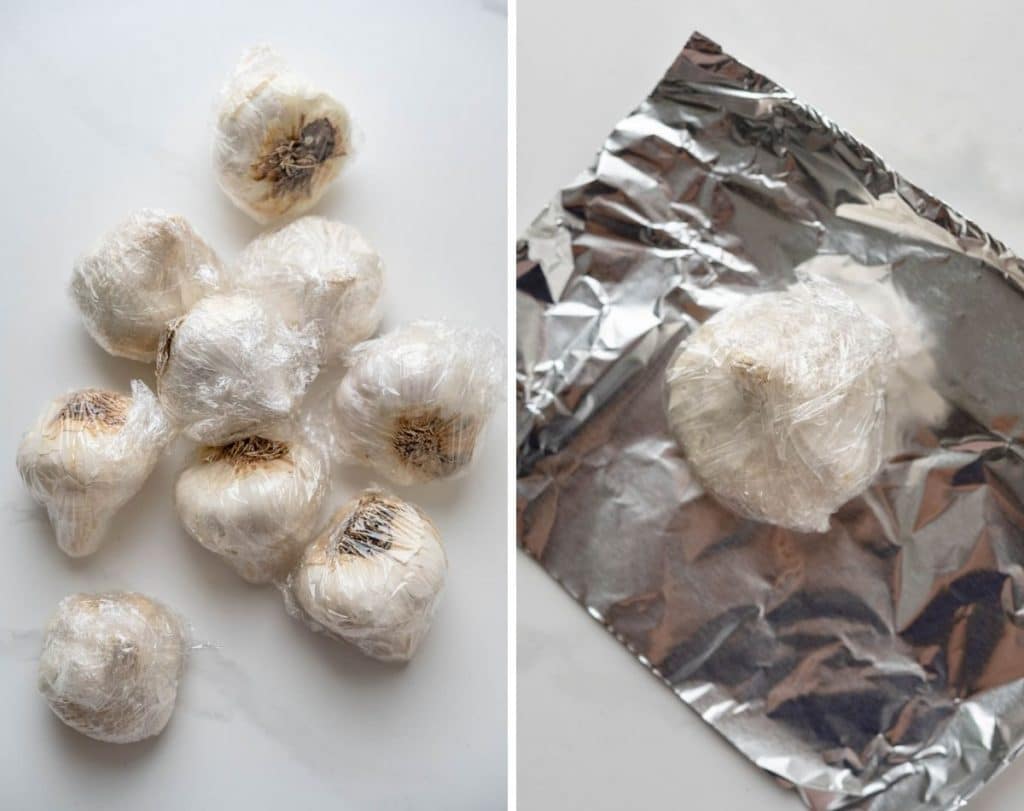
What you’ll need to make black garlic at home:
- Multiple whole heads of fresh garlic.
- Plastic wrap.
- Tin foil.
- An Instant Pot, Slow Cooker, Rice Cooker for Food Fermenter.
- An area of the house that you can close off, a garage, or covered outdoor space.
- Patience. This isn’t a quick process and can take anywhere from 3 weeks to 2 months.
I used an Instant Pot (not so instant for this recipe) for this demonstration, but you’ll have equal success with any other equipment mentioned.
Setting up the garlic station
I recommend setting up your Instant Pot, slow cooker, rice cooker, or food fermenter in a well-ventilated outdoor space (that’s covered from the elements), a garage, or a separate room that can be closed off from the rest of the house.
Why? The garlic aroma (especially at the beginning of the process) can be powerful and last up to two weeks.
I put my Instant Pot in a spare bedroom, opened a window, and closed the door (and even then, a garlicky aroma drifted down the hall). This room has since become known as “the garlic room,” — and it took a bit of airing out (and Febreeze) to get it back to normal after making the black garlic.
If you’re very sensitive to strong odors, be sure to set up your equipment outside or in a well ventilated garage.
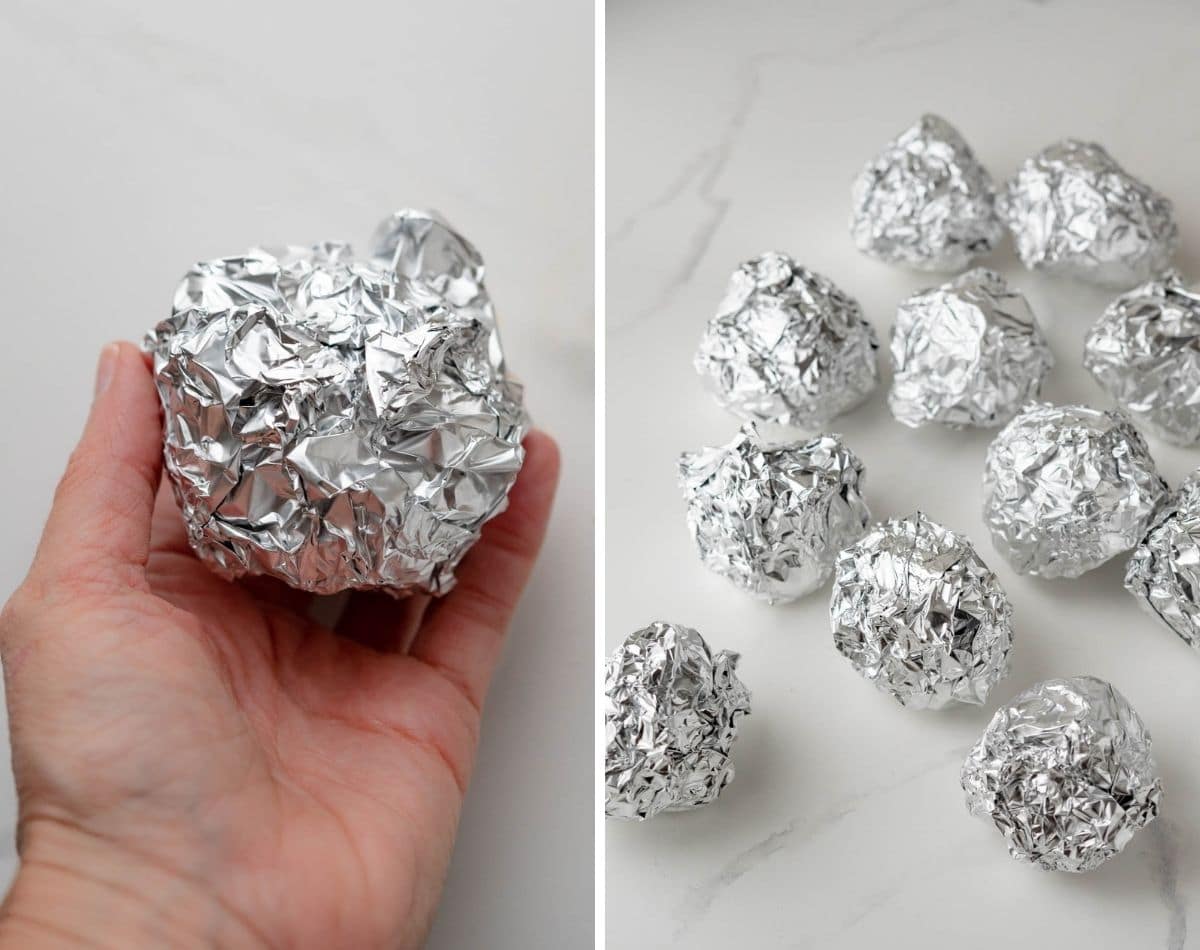
Making black garlic is easy; it’s just a matter of time and patience.
Because it’s such a long process, I recommend making a big batch so you’ve got plenty for yourself and to give as gifts to all your foodie friends and relatives.
I made 16 heads of garlic for this batch. You can do more or less, depending on how much you need, but if I’m fermenting one head of garlic, it makes sense to make a big batch. The aromas are just as potent with one as they are with many.
How to make fermented garlic in the Instant Pot
- Wrap the whole bulbs of fresh garlic in plastic wrap.
- Then wrap the bulbs in two layers of tin foil.
- Place a rack in the Instant Pot to elevate the garlic off the container’s bottom.
- Add the foil-wrapped garlic to the Instant Pot and seal with the lid.
- Turn the setting to “warm.”
- Set the timer to the most extended setting (99:59 — 99 hours and 59 minutes) and start. The Instant Pot will stop every four days, so you’ll have to reset it to warm every time the clock runs down.
- Look at the calendar and circle three weeks into the future. That’s when you’ll start checking the heads of garlic.
How to know when black garlic is done
- Start checking on the garlic after about one month using the same bulb as your “official tester.”
- Unwrap it and pull off one clove of garlic. Remove the papery skin to check on the progress. (After about one month, mine was a light caramel color, and the garlic was still very firm.)
- Rewrap the bulb and put it back in the Instant Pot for another week.
- Keep checking every week for another 5-6 weeks until you achieve dark black garlic that’s soft, tender, and sticky to the touch. (The photo below shows what the black garlic should look like).
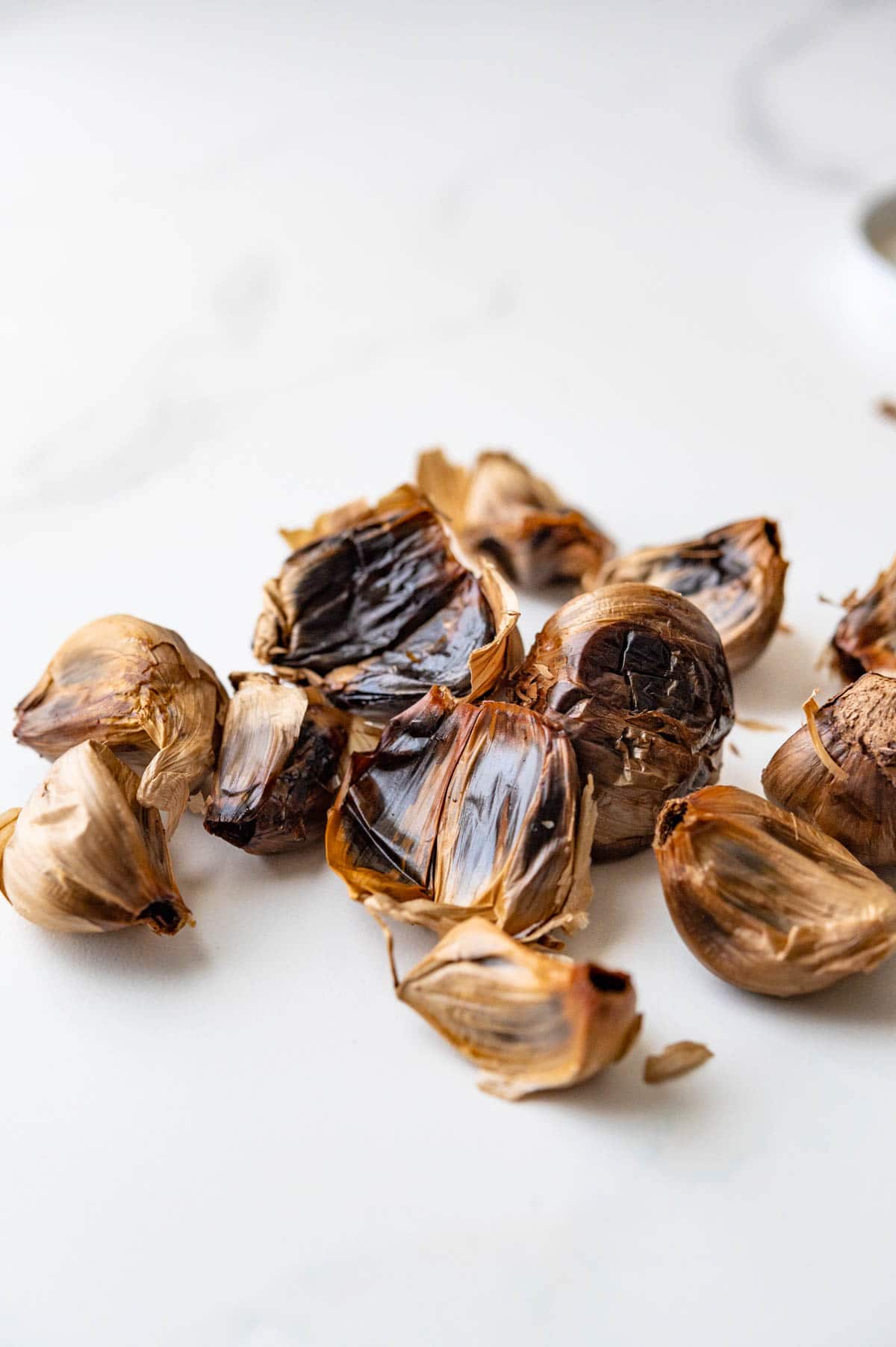
Making black garlic in the slow cooker or rice cooker
The process for making it in a slow cooker or even a rice cooker is the same as the Instant Pot. Wrap the individual bulbs in plastic wrap and two layers of foil, place a rack on the vessel’s floor, so the garlic isn’t resting directly on the bottom, and set the heat to “warm.”
Start checking the garlic after about four weeks for doneness. If it’s not soft and black, wrap it back up and give it another week.
Pro-Tip: You can continue “cooking” garlic, past the point of just turning black. The longer it dehydrates, the more concentrated the flavors and the deeper the complexity.
Making black garlic in a food fermenter
Want to speed up the fermentation process by a few weeks? Try a food fermenter {affiliate link}. These gadgets can cut the time needed to make black garlic cloves by half. They’re a bit pricey, but you can use these devices for everything from making sweet rice to yogurt.
FAQ’s
Yes! In addition to its complex flavor, black garlic can help regulate blood sugar levels, triglycerides, and cholesterol.
It can help to reduce the growth of colon cancer cells and block the development of free radicals.
Black garlic’s anti-inflammatory properties are good for brain health, too, and may help prevent conditions such as Alzheimer’s and Parkinson’s Disease and help overall cognition.
It’s also been found to boost the immune system and may improve liver health.
You can store glass jars or even small brown lunch bags of black garlic in a cool, dry, and dark spot, like a pantry. It can also be refrigerated or frozen.
Keep black garlic for 2-3 months or even longer at room temperature. If you’re squeamish about that, feel free to store it in the fridge for up to 10-12 months or well-wrapped in the freezer for a year or more.
What about food safety?
I received this comment from Liz about black garlic immediately after publishing this article and felt it essential to let you decide:
Making black garlic at home can be dangerous. The temperature must be maintained and monitored, and ph levels have to be correct, or it can produce botulism and other toxins…
This is what food safety expert Dr. Brian Nummer Ph.D. has to say about making black garlic –
“The “fermentation” temperature MUST be at 57°C (135°F) or above. Failing to maintain this temperature control could lead to foodborne illness. Foodborne illness bacteria will begin to grow at temperatures just under 57°C (135°F), including Clostridium perfringens and Clostridium botulinum. The toxin produced by C. botulinum is the most potent and deadly toxin known to man. For that reason, a temperature datalogger is recommended.”
“The black garlic fermentation is quite different than a traditional vegetable fermentation like sauerkraut (cabbage) or pickles (cucumbers). Both cabbage and cucumbers have natural (biota) lactic acid bacteria that rapidly ferment the vegetable sugars in a salt brine at ambient temperatures. This rapid fermentation inhibits the growth of pathogens like C. botulinum. Once the brine reaches an acidity pH of 4.6 or less, C. botulinum cannot grow. The black garlic fermentation may or may not result in an acid fermentation.”
Clearly, Liz has misgivings, so if you’re in her camp, skip this DIY and get your black garlic from a reputable source… {affiliate link}, because it’s a flavor you don’t want to miss.
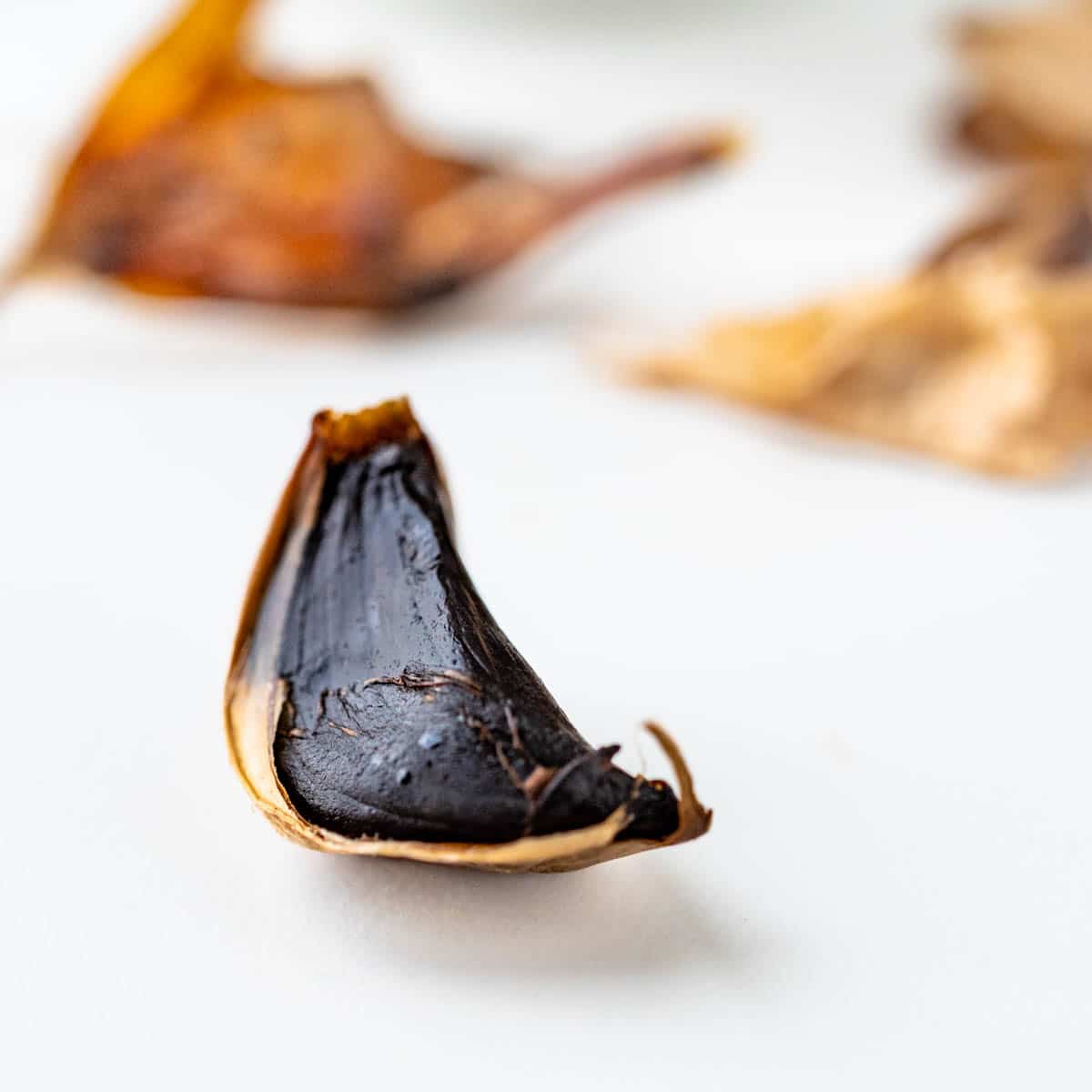
How to use black garlic
Strip the papery skins from black garlic and mash it into a paste to spread on toast or mix in as a “secret ingredient” in everything from stir fries to hamburgers. It’s fantastic on steaks, excellent with pasta, and gives a flavorful bite to steamed veggies.
One of my favorite (and most accessible) uses is to mash equal parts black garlic and good butter together to form a paste, then top a grilled steak with the funky, umami spread and a bit of chopped parsley. The sweet and tangy garlic undertones are incredible, and your diners will ask, “what’s that flavor?” as they return for another bite.
Since you’ll likely be making black garlic in a big batch, I recommend sharing it with all your foodie friends. Give a jar as a hostess gift. They’ll love it.
I gave one to my Mom, who was so excited she immediately removed the lid to take a deep whiff of the funky fermented garlic aroma. She’s already planning what she’ll do with hers.
Black garlic as seen on Instagram:
- BBQ’d Nachos with Smoked Black Garlic from @FifthGenGardens
- Sweet Black Garlic& Miso Chocolate Chip Cookies by @lizlerma27
- Sausage and Black Garlic Pasta via @lisahculley
- Black Garlic, Shallot, Green Beans, Lemon, and Hazelnuts from @foodbyhermood
- Crispy Chicken Thighs with Creamy Black Garlic Sauce by @theblackgarlicph
- Black Garlic Baba Ganoush from @meatlessmakeovers
- Black Garlic Scallops via @garlic_farm
- Oriental Black Garlic Chicken by @theworldisyourcookpot
- Black Garlic Chocolate Guinness Cake from @sheppherd_bobbi
Here’s a quick and easy way to use your ebony cloves of garlic: Black Garlic Vinaigrette for salads or add several cloves of black garlic purée to this marinade recipe. It’s great with beef, lamb, pork, and poultry.
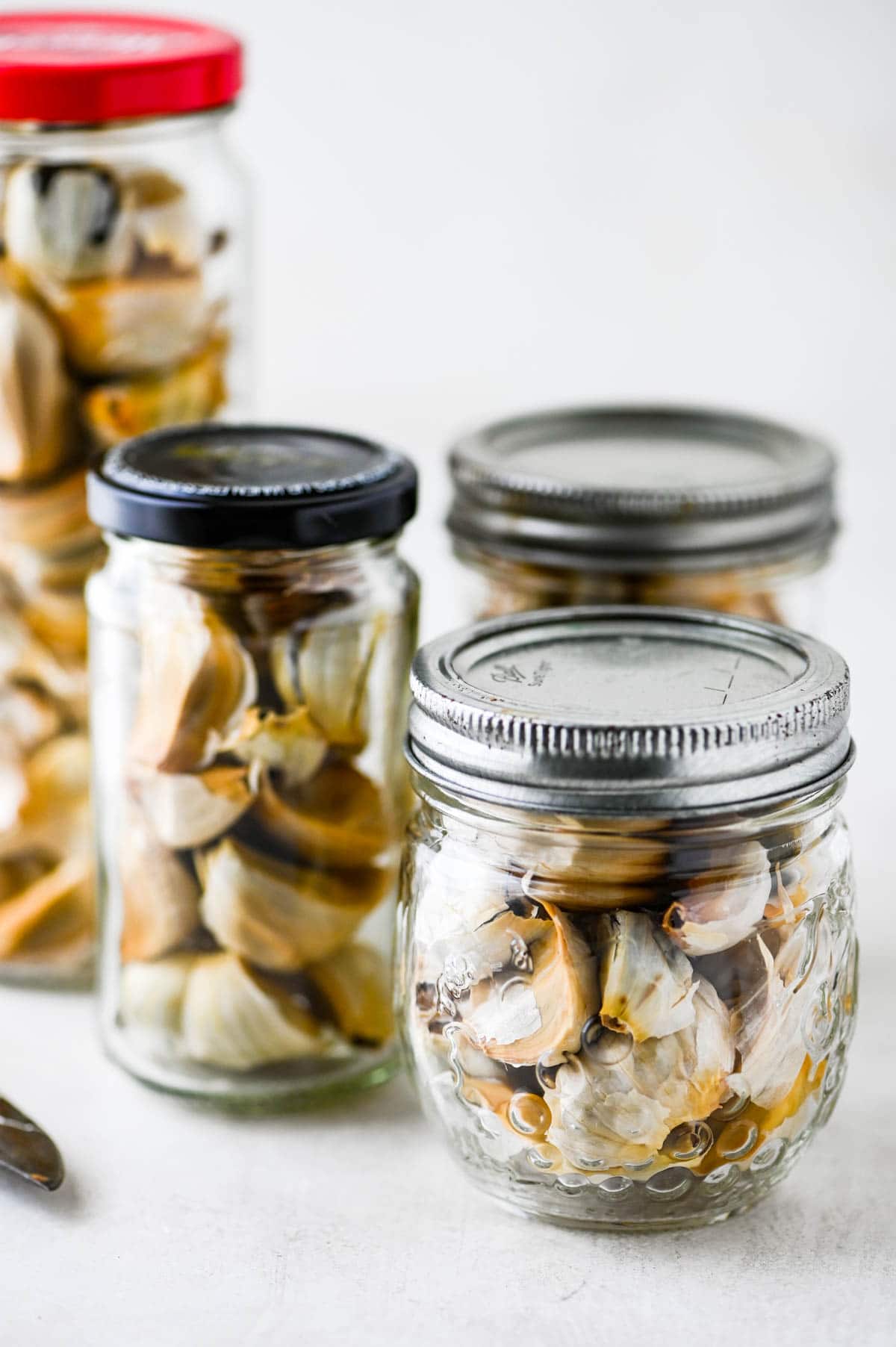
This website isn’t named Garlic & Zest for nothing…
Here’s more garlicky recipes you’ll love:

Tried this recipe? Leave a rating and review.
Your comments and shares are invaluable to me and the thousands of readers who use this site daily. If you've made the recipe, leave a star rating and review. We want to hear how you liked it.
We'd love it if you shared the recipe with your friends on social media!
How To Make Black Garlic
SPECIAL EQUIPMENT:
- Instant Pot
- plastic wrap
- tin foil
INGREDIENTS:
- 16 heads garlic
DIRECTIONS:
- Tear 16 pieces of foil (about 6″ wide) from a roll of tin foil. Stack the foil and use a pair of scissors to cut the foil in half horizontally. Set aside.
- Cut pieces of plastic wrap (about 5″ wide and large enough to wrap an individual head of garlic). Wrap one head of garlic tightly in each bit of plastic and set aside.
- Wrap the individual heads of garlic in one piece of foil. Then wrap it in another piece of foil and set aside. Continue to double wrap the garlic until each head has been covered.
- Place a rack in the bottom of the Instant Pot and add the wrapped garlic.
- Secure the lid with the vent closed. Set the Instant Pot to “Keep Warm” and set the timer for 99 hours. (Note: you’ll have to continue to set the timer every 4 days until the garlic is done).
- Let the garlic ferment in the warm environment for 3 weeks (resetting the timer as necessary.
- Remove the foil and plastic wrap and store the black garlic in airtight containers at room temperature.
RECIPE VIDEO:

NUTRITION:
Pin It For Later!
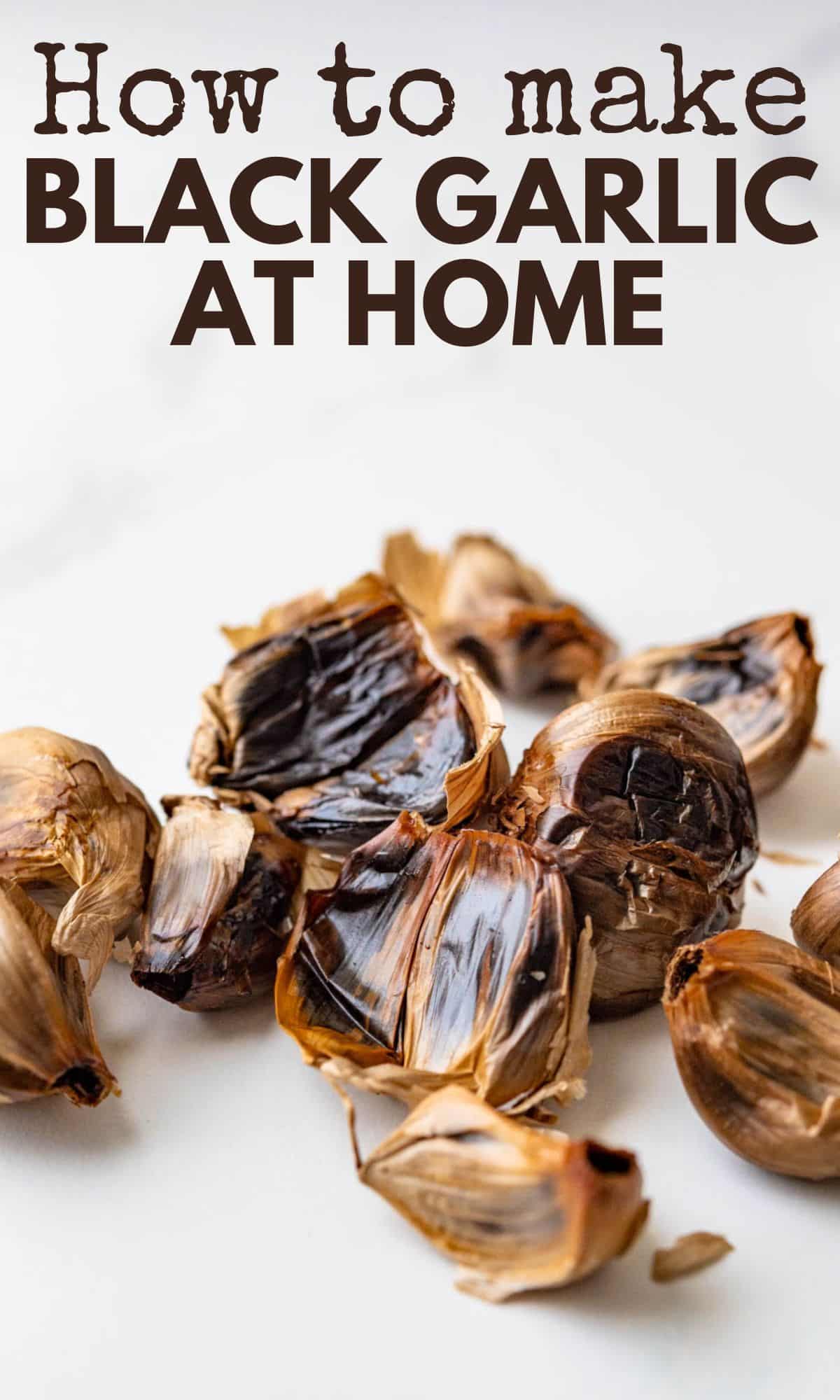

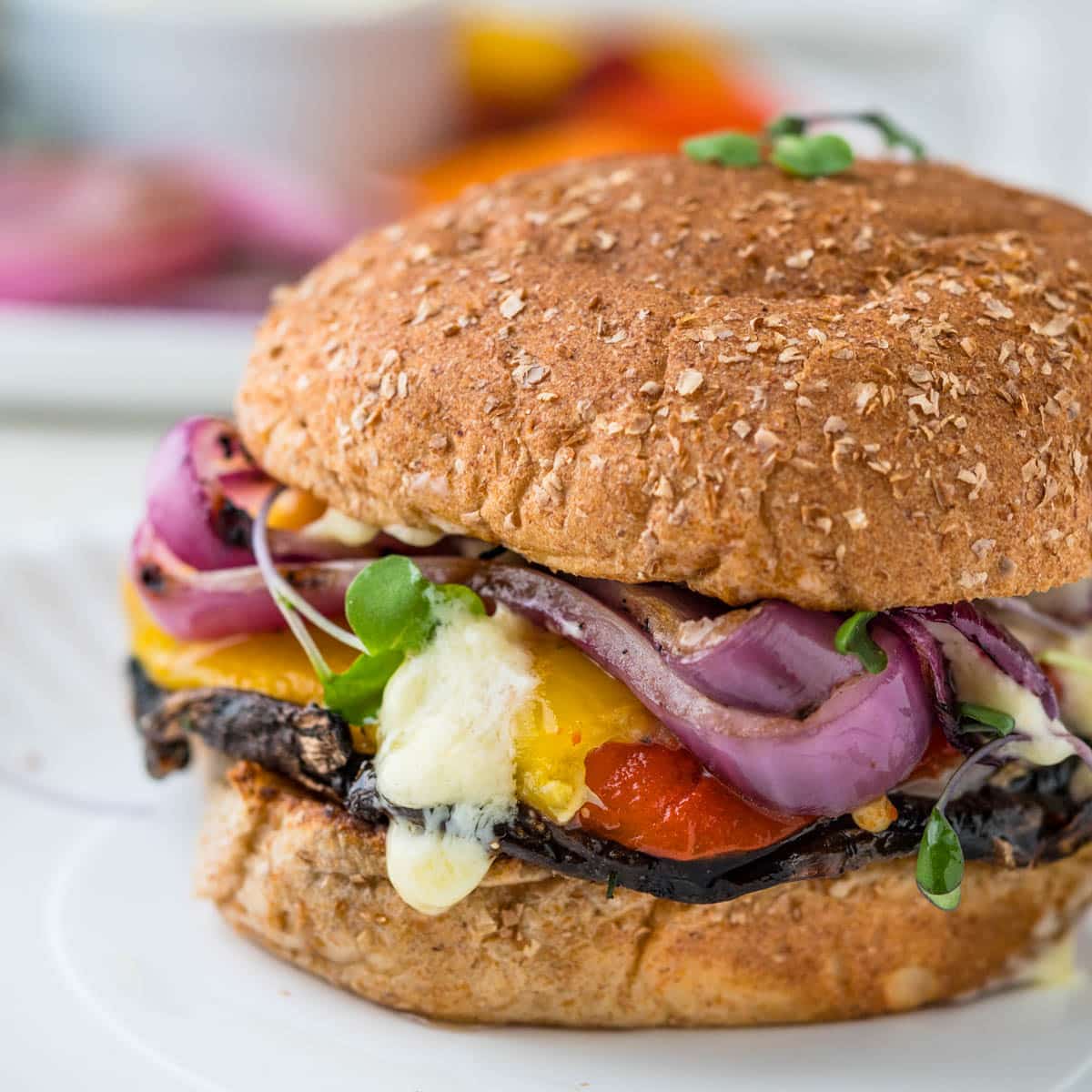
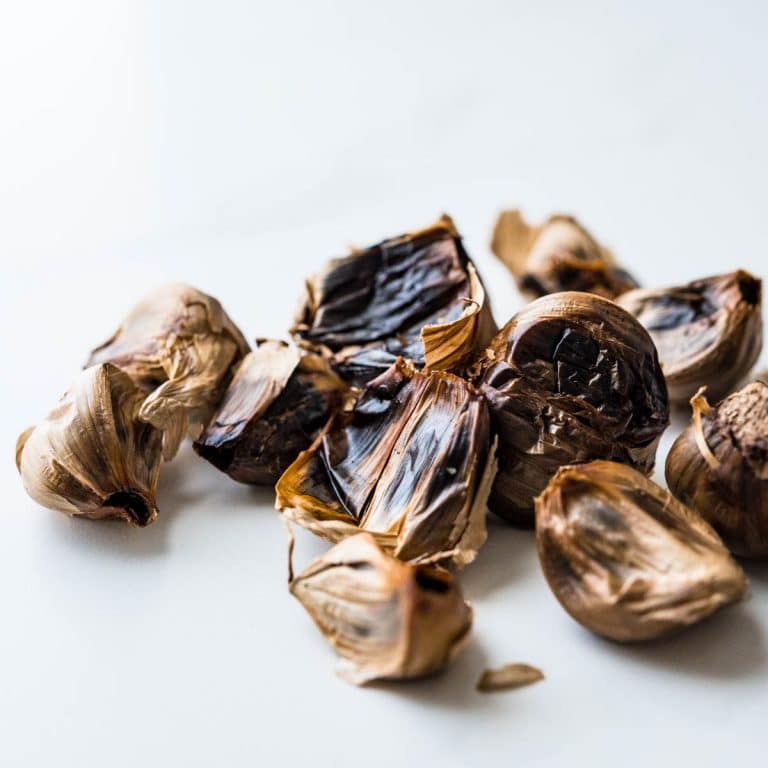
So, basically the same method but with different equipment. I’ve heard you can make it with wax without any equipment.
Thanks for interesting artikkel.
Do you have any idea of maximum temperatur, thinking of trying the pressure cooker, whit water inside, idea is that no wrapping would be needed cause the high level of moist inside the cooker, but I guess the temperatur be difficult to control, coming to high the feds will be cooked I guess 😉 and the fermenting prosess never happens, just a silly question from at total amateur.
You checked the garlic at 4 weeks and then once a week for another 5-6 weeks so the total time was 9-10 weeks correct?
Yes!
What model / version of instant pot can the warming function be programmed to 99 hours?
I am on my third different version of the Duo model and they only allow up to 10 hours. I called Instant Pot customer care and they could not answer me. Their recommendation was to use the slow cooker function at low temperature setting to be able to program to 99 hours. However the slow cooker function low temperature is too hot for this process. The warm function has the correct temperature on low of 145F.
Mine is model #IP-DUO60V3
Hello Ted,
145°F should actually be fine. Just read this academic article (https://pubmed.ncbi.nlm.nih.gov/26212875/) that suggested that 70°C (158°F) is the optimal temperature for black garlic formation. Just did a batch of 30 heads and I would agree with their assessment. Really delicious and only took 1 month’s time! Really as long as you keep your temp above 56°C you’re good. That’s the temperature at which the bacteria responsible for Botulism dies 😉
Happy cooking!
-Shawnee
Do you leave the pressure valve on the instant on the on or off position?
You’ll definitely want the pressure valve on — the aromas are strong enough that way, it would be way too stinky if you let it air!
you use fresh garlic bulbs are they fresh from farmers market or could I just use garlic from Walmart store as it is cheaper
You can use garlic from the store.
I’m worried about the plastic. There is lots of evidence that heating food in plastic means that you will be eating the microplastic that is released. Even without heating, plastic releases micro plastics. I’ve read recipes without plastic, but they say don’t let the heads of garlic touch each other. That means you can’t do many heads at a time.
I’d love to know how it was made before rice cookers, slow cookers etc and before plastic and foil. I’ve researched, but can’t find any information. Do you happen to know?
Looking into this.
How do you store it once your done? I noticed a picture with the garlic in glass jars. How long will it last in a jar? Store in cool dark place? Refrigerator?
I store in the pantry in a glass jar for up to 6 months… It may be good beyond that point as well… just haven’t gotten that far yet.
Hi! I just started a batch a couple days ago but my recipe didn’t say to wrap them? Do I need to?
My thought is that wrapping them in plastic and then in foil will help maintain the humidity level and help in the fermenting process. That’s not to say it couldn’t work if you didn’t wrap them — maybe someone else has a different method that works for them.
When garlic goes back down on price I will try doing black garlic..
Hi excited to continue with my black garlic journey. I’m starting to find out I must ferment at a longer process time for the results to get the whole bulb, opposed to the cloves which is a shorter process time . My question is I have a lot of frozen garlic Can I put the frozen garlic directly in the fermenting machine keep at 57c I believe and of course its longer time period for the results I’m trying to achieve , which is a whole bulb fermented not the cloves very frustrating to peel cloves then dealing with the whole bulbs .
your thoughts ? thank you so much for any advice in advance.
Stephen Ruiz
I’ve never used frozen garlic, but I don’t see why you couldn’t ferment it with your method of choice.
You do realize without following
food safety guidelines, proper procedures and using the correct equipment, making black garlic at home can be dangerous? Temperature must be maintained, monitored and ph levels have to be correct or it can produce botulism and other toxins…
This is what food safety expert, Dr. Brian Nummer PhD has to say about making black garlic-
“The “fermentation” temperature MUST be at 57°C (135°F) or above. Failing to maintain this temperature control could lead to foodborne illness. Foodborne illness bacteria will begin to grow at temperatures just under 57°C (135°F) including Clostridium perfringens and Clostridium botulinum. The toxin produced by C. botulinum is the most potent and deadly toxin known to man. For that reason a temperature datalogger is recommended.”
“The black garlic fermentation is quite different than a traditional vegetable fermentation like sauerkraut (cabbage) or pickles (cucumbers). Both cabbage and cucumbers have natural (biota) lactic acid bacteria that rapidly ferment the vegetable sugars in a salt brine at ambient temperatures. This rapid fermentation inhibits the growth of pathogens like C. botulinum. Once the brine reaches an acidity pH of 4.6 or less, C. botulinum cannot grow. The black garlic fermentation may or may not result in an acid fermentation.”
It’s not as easy as you think, even if you made one batch on your “Insta Pot” and did not have any issues. People could get sick encouraging this. Leave it up to the professionals.
Cannot wait to try this! Gold!